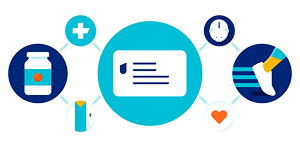It’s common to feel a range of emotions from time to time, including emptiness, anxiousness or sadness. But if you find yourself feeling unhappy for several weeks or more, and it interferes with your daily life, you may be depressed.
While sadness is an emotion, depression is a mental health disorder. Depression often requires medical treatment. The good news is that, whether you’re experiencing sadness or depression, there are ways to start feeling better.
A mental health professional can help treat anxiety and depression, sleep issues, relationship conflicts and more. Explore Mind Your Health™ to see how you can save money and get you better care.
What is sadness?
Sadness is an emotion triggered by something that happens in your life. This could be an event that makes you sad. It could, for example, be triggered by the loss of a job, pet or loved one. Loneliness can also bring about feelings of sadness.
When you’re sad, you may react by crying or spending more time alone. With sadness, however, you’ll likely find that you’ll feel better over time. While you can’t bring your pet or loved one back to life, for example, time will heal your sadness. You’re usually able to move forward with your life.
But if the feelings of sadness don’t go away and affect your daily life, you may be depressed.
What is depression?
Depression is more than just an emotional response to an event or a loss. It’s a mood disorder that persists. It often interferes with your everyday life and makes it hard to function.
You may have depression if you’re experiencing symptoms like:
- Changes in appetite or unplanned changes in weight
- Difficulty sleeping or sleeping too much
- Feeling easily frustrated
- Having trouble concentrating
- Irritability
- Lack of energy
- Loss of interest in hobbies
- Not wanting to do activities that used to be fun
- Physical aches or pains
- Thoughts of hurting yourself or suicide
If you’re thinking about hurting yourself or experiencing thoughts of suicide, it’s not something to take lightly. You should seek immediate help. You can call 911. Or call the National Suicide & Crisis Lifeline at 988. It offers free and confidential emotional support.
Women are more prone to being diagnosed with depression. About 1 in 10 women show traditional signs of depression. That may be because depression doesn’t always look the same for everybody.
For example, men and women might experience different symptoms. Women might feel sad, worthless and guilty, while men may feel irritable and aggressive. Men are also more prone to coping by using alcohol or drugs. Likewise, men might experience headaches, chronic pain or their heart might race, while women might experience changes in appetite.
Some women are also prone to depression after having a baby. Postpartum depression can cause a feeling of detachment from their baby. It can also cause feelings of guilt, sadness, anger and worry.
Sadness vs. depression: What’s the difference?
The main difference between sadness and depression is that depression lasts for a longer period of time. To be diagnosed with depression, your symptoms have to be present for longer than 2 weeks. Depression also interferes with your quality of life.
If you’re unsure whether you’re experiencing sadness or depression, your doctor might recommend that you take the Patient Health Questionnaire. It’ll ask you to answer questions like:
- Are you experiencing little interest or pleasure in doing things?
- Are you feeling down, depressed or hopeless?
- Are you feeling tired or like you have little energy?
- Are you having trouble falling or staying asleep? Or have you been sleeping too much?
- Are you feeling bad about yourself?
- Are you feeling that you’re a failure? Or feeling that you’ve let yourself or your family down?
- Are you having trouble concentrating on things, such as reading or watching TV?
- Are you moving or speaking slowly? Or have you been fidgety or restless?
- Are you not eating enough or overeating?
- Are you thinking that you would be better off dead?
- Are you thinking about hurting yourself in some way?
If you’ve been experiencing these symptoms for weeks, you may want to reach out to a mental health provider for help. And as noted above, if you’re thinking about hurting yourself or having thoughts of suicide, you should seek professional or emergency help immediately.
Is cost or access keeping you from getting the mental health care you need? Explore our telehealth membership, which has a flat monthly fee and covers all your virtual appointments.
How do doctors treat depression?
If you’re depressed, getting help and treatment may help relieve your symptoms. It may also help you to start feeling happier and more engaged in life.
There are 2 ways to get help. One is through therapy with a mental health provider. The second is by getting medication to help relieve symptoms. The 2 treatments may also be combined. Here are some examples of each:
Therapy for depression. There are various forms of therapy that can be beneficial. One is cognitive behavioral therapy, or CBT. This type of therapy helps you recognize how you’re thinking and acting. And it helps you to find ways to think and behave differently.
Another type is mindfulness-based cognitive therapy, or MBCT. This uses mindfulness to help you better understand and manage feelings. (Mindfulness is your ability to maintain a nonjudgmental, present-moment awareness of your thoughts, feelings, body sensations and surroundings.)
During therapy sessions, you’ll focus on your thoughts and feelings. And you’ll work with a therapist or counselor to improve coping skills.
Medication for depression. Your doctor or psychiatrist may prescribe medication, such as antidepressants, to treat a depression diagnosis. These work by changing the way your brain produces or uses chemicals that affect your mood. Your mental health provider will work with you to find an antidepressant that works best for you.
It’s worth noting that it can often take time for antidepressants to feel like they’re working. That’s because you might react differently than someone else to a certain type of medication or dose. It may take 4 to 8 weeks (about 2 months) to feel the most benefit.
It’s important to not stop taking your medication without first talking to your provider. Abruptly stopping a medication such as an antidepressant may cause withdrawal symptoms.
How do you cope with feelings of sadness?
If you are experiencing feelings of sadness, there are steps you can take to feel better. One great option is through regular exercise. You may want to try yoga or walking. Just 30 minutes of walking per day has been shown to boost mood.
You’ll also want to get your diet in order, and make sure you’re eating healthily. Other strategies that may help:
- Breaking up tasks into smaller, more manageable ones
- Delaying making important decisions until you feel better
- Maintaining a regular bedtime and wake-up schedule
- Reaching out for support from friends or family
Additionally, it’s a good idea to quit smoking and stop drug and alcohol use. These habits can all make feelings of sadness and depression worse.
Bottom line: Whether you’re experiencing feelings of sadness or depression, know there are things you can do to feel better. The first step is understanding what you’re experiencing. The next step is reaching out for help.
Find virtual mental health plans that offer therapy, coaching and online content. Check out the Teladoc Mind Your Health today, or call 1-844-211-7730 for more information.
This article contains information that is compiled by UnitedHealthcare or its subsidiaries. UnitedHealthcare does not represent all the information provided are statements of fact. Please consult directly with your primary care physician if you need medical advice.
Sources:
American Psychological Association. “Patient Health Questionnaire-9 (PHQ-9).” Retrieved from https://www.apa.org/depression-guideline/patient-health-questionnaire.pdf Accessed April 1, 2024
Brain Imaging and Behavior. “Brain-based sex differences in depression: a systematic review of neuroimaging studies.” April 14, 2023. Retrieved from https://www.ncbi.nlm.nih.gov/pmc/articles/PMC10102695/
Brown University School of Professional Studies. “Comparing evidence-based mindfulness programs: MSBR vs. MBCT.” November 28, 2023. Retrieved from https://professional.brown.edu/news/2023-11-28/mbsr-vs-mbct
Centers for Disease Control and Prevention. “Depression among women.” May 22, 2023. Retrieved from https://www.cdc.gov/reproductivehealth/depression/index.htm
Centers for Disease Control and Prevention. “Mental health conditions: depression and anxiety.” October 13, 2023. Retrieved from https://www.cdc.gov/tobacco/campaign/tips/diseases/depression-anxiety.html
Centers for Disease Control and Prevention. “Sadness and depression.” May 26, 2023. Retrieved from https://www.cdc.gov/howrightnow/emotion/sadness/index.html
National Institute of Mental Health. “Depression.” September 2023. Retrieved from https://www.nimh.nih.gov/health/topics/depression
National Institute of Mental Health. “Psychotherapies.” February 2024. Retrieved from https://www.nimh.nih.gov/health/topics/psychotherapies
Stanford University Medicine. “Feeling lonely? You’re far from alone: Expert advice on how to get reconnected.” November 30, 2023. Retrieved from https://scopeblog.stanford.edu/2023/11/30/feeling-lonely-youre-far-from-alone-expert-advice-on-how-to-get-reconnected/
Compliance code:
50909-X-0524










